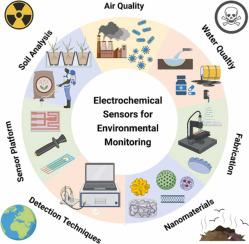Trends in Environmental Analytical Chemistry ( IF 11.2 ) Pub Date : 2023-02-11 , DOI: 10.1016/j.teac.2023.e00199 Ahmed Barhoum , Selma Hamimed , Hamda Slimi , Amina Othmani , Fatehy M Abdel-Haleem , Mikhael Bechelany

|
In recent decades, much attention has been paid to using nanomaterials in the development of highly-sensitive sensors for environmental monitoring. This review describes how nanomaterials are being used to develop electrochemical sensing platforms for environmental analysis (air pollution, water quality, soil nutrients, and soil pathogens). In particular, we discuss the use of nanofabrication techniques (e.g., monolayer self-assembly, drop-casting, molecular imprinting, electrodeposition, in situ polymerization, hydrogenation, and 3D printing) in the fabrication of high-sensitive electrodes is addressed. The potential use of carbon, organic, inorganic, and hybrid nanomaterials in electrochemical sensing platforms and to enable automation, real-time detection, and multiplexed test development are also addressed. Recent applications of mobile, disposable, wearable, implantable, and self-powered electrochemical sensors for monitoring ions, particles, compounds, nutrients, microorganisms, and contaminants in real environmental samples are covered. Finally, the opportunities and challenges in nanofabrication high-performance electrochemical sensors and optimizing their performance in testing real samples are highlighted.
中文翻译:

用于环境分析的电化学传感器平台的现代设计:原理、纳米制造机会和挑战
近几十年来,利用纳米材料开发用于环境监测的高灵敏度传感器受到了广泛关注。这篇综述描述了如何使用纳米材料开发用于环境分析(空气污染、水质、土壤养分和土壤病原体)的电化学传感平台。特别是,我们讨论了纳米制造技术(例如,单层自组装、滴铸、分子印迹、电沉积、原位聚合、氢化和 3D 打印)在高灵敏度电极制造中的应用。还讨论了碳、有机、无机和混合纳米材料在电化学传感平台中的潜在用途,以及实现自动化、实时检测和多重测试开发的潜力。最近的手机应用,涵盖了用于监测真实环境样品中的离子、颗粒、化合物、营养素、微生物和污染物的一次性、可穿戴、可植入和自供电电化学传感器。最后,强调了纳米制造高性能电化学传感器的机遇和挑战,以及优化其在测试真实样品中的性能。



























 京公网安备 11010802027423号
京公网安备 11010802027423号